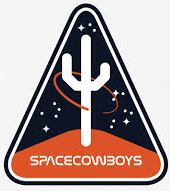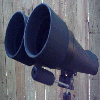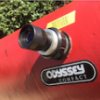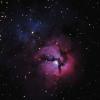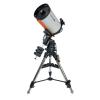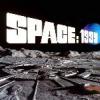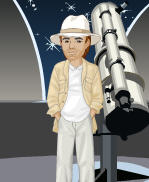
Meet DA14's little brother?
#51

Posted 19 February 2013 - 06:29 PM
#52

Posted 19 February 2013 - 06:40 PM
In comparison, stony meteorites (chondritic and achondritic) have accounted for 85 recovered falls.
In a little over 13 years, we have had 86 total known meteorite falls. Only one of which was an iron.
The Kavarpura iron meteorite was a single recovered mass of less than 7 kilograms and didn't cause any destruction. I do not know it's size before it entered the atmosphere, went through the process of ablation, and then hit the ground as a grapefruit-sized, regmaglypted mass. The only possible sign of it's fall may have been a tiny dent or impact pit in the target ground that would not qualify to be called a "crater".
The term "city killer" comes into play with BIG iron bodies that come in just the right way and do not explode high in the atmosphere.
As was said earlier by someone else, a stony meteorite often does not survive the stresses atmospheric entry and they disrupt or explode much sooner and farther from the ground - producing an impressive visual display and one heck of a shockwave, but little relative damage on the ground.
This is what happened with the Chebarkul event - the angle of entry, speed of entry, the size of the body, and the composition of the body resulted in a cosmic starter pistol shot. It was loud, it got everyone's attention, but it was harmless in the grand scheme of potential impactors. Or to use the more popular analogy - this was a shot across our bow.
Play with the numbers in the simulator a little bit and you get a much deadlier result from a similar sized body of a different composition that enters our atmosphere at a higher velocity and at a more extreme/vertical angle.
This Russian meteorite could have been a Canyon Diablo crater-maker. Or Chicxulub. We should be able to detect the "planet killers" at a greater distance, but the so-called "city killers" can be frightfully small and hard to detect before it's too late. We need improvements in our detection systems.
We've had 86 warnings in the last 13+ years. This was the biggest and most damaging one since Tunguska, and we would be wise to continue improving our monitoring systems and perhaps accelerate the pace of that improvement. It's not being paranoid, it's being prudent.
Best regards and clear dark (and safer) skies,
MikeG
#53

Posted 20 February 2013 - 12:48 AM
There's another idea - we (well NASA) frequently use close passes to boost the speed of a probe - the "slingshot". I wonder what geometry would be needed to cause the reverse and reduce speed, and IF it's practical. (Planets have captured moons on occasion.) Though it might not work on something on DA14's path as it's far out of plane...?
This one is easy - to gain velocity via slingshot, you have your probe approach the planet from ahead of it in it's orbit. It swings in close and goes back out at the nearly same speed relative to the planet, but since it came from ahead of the planet it can gain up to 2x the planet's orbital velocity. In the simplest scenario, the probe is sitting still as the planet approaches at orbital velocity, it slingshots around the planet and ends up moving ahead of the planet by the same velocity (at orbital velocity relative to the planet, so now at 2x orbital velocity relative to the sun).
To lose speed, you have it approach from behind the planet in its orbit. Again, in the simplest form the probe comes up from behind at 2x the orbital velocity, for a relative velocity equal to orbital velocity. It swings around and leaves at orbital velocity relative to the planet, but now is sitting still relative to the sun.
Jarad
I think that's backwards, Jarad. Every diagram I've ever seen, and every gravitational simulation I've done, increases the passing body's energy when it approaches from behind the orbital path of the larger planet. Here's a typical example.
The trick is that the probe (or asteroid) are both going in the same direction relative to the Sun, the larger planet pulling the small trailing probe towards it means that the probe gains much more velocity in the direction of its orbit around the Sun than the planet loses. If it passes in front of the planet, it's pulled back in velocity relative to the Sun.
The best way for it to be captured is for its perihelion to be just inside the orbit of the planet, so it's at the slow point of its velocity just as the planet catches up. There are other ways, but they involve more complex motions and often multiple encounters.
Of course, if the probe is in a retrograde orbit, that's a whole 'nother issue.
#54

Posted 20 February 2013 - 07:35 AM
I think that's backwards, Jarad. Every diagram I've ever seen, and every gravitational simulation I've done, increases the passing body's energy when it approaches from behind the orbital path of the larger planet. Here's a typical example.
We are saying the same thing, just mis-communicating about reference frames. The probe leaves going in roughly the opposite direction it approached from, relative to the planet. To gain speed, it comes in from in front of the planet, swings around behind it, and leaves going out ahead of it again. The closest point where it swings around is on the opposite side that it approached from.
For the slingshot boost scenario, they will usually both be going in the same direction relative to the sun, but the probe is going slower at first (so in the planet's reference frame, it is coming towards the planet from in front of it in orbit). After the swing, they are both going in the same direction, but the probe has picked up speed (in the planet's frame, the probe did a U-turn around the planet and is now headed in the opposite direction it started in).
Of course, that's the most extreme example. In reality, it will be a hyperbola, not a perfect U. More of a V with a curved bottom. If the open end of the V points forward in the planet's orbit, then the probe gains speed. If the open end points backward, it loses speed. By angling the V relative to the orbit, you can also change direction as well as speed (and of course in orbital mechanics changing speed cause a change in direction anyway...).
It only looks like a U in the planet's reference frame. From the sun's reference frame (how the diagram in the link is drawn) it looks much wider, since both objects are moving forward while the probe swings around the planet.
Jarad
#55

Posted 20 February 2013 - 09:43 AM
I am glad you guys are here for the parts of this that make my head explode. I can imagine the details once you fine gentlemen explain the mathematics and dynamics at work. I am completely right-brained and have little grasp of numbers. Without the explanations you offer here, I'd just be imagining rocks hitting a windshield with little understanding of how.
Just wanted to say thanks for that.
Best regards,
MikeG
#56

Posted 20 February 2013 - 03:33 PM
http://www.answers.c...opic/regmaglypt
Dave Mitsky
#57

Posted 20 February 2013 - 10:02 PM
I think that's backwards, Jarad. Every diagram I've ever seen, and every gravitational simulation I've done, increases the passing body's energy when it approaches from behind the orbital path of the larger planet. Here's a typical example.
We are saying the same thing, just mis-communicating about reference frames. The probe leaves going in roughly the opposite direction it approached from, relative to the planet. To gain speed, it comes in from in front of the planet, swings around behind it, and leaves going out ahead of it again. The closest point where it swings around is on the opposite side that it approached from.
For the slingshot boost scenario, they will usually both be going in the same direction relative to the sun, but the probe is going slower at first (so in the planet's reference frame, it is coming towards the planet from in front of it in orbit). After the swing, they are both going in the same direction, but the probe has picked up speed (in the planet's frame, the probe did a U-turn around the planet and is now headed in the opposite direction it started in).
Of course, that's the most extreme example. In reality, it will be a hyperbola, not a perfect U. More of a V with a curved bottom. If the open end of the V points forward in the planet's orbit, then the probe gains speed. If the open end points backward, it loses speed. By angling the V relative to the orbit, you can also change direction as well as speed (and of course in orbital mechanics changing speed cause a change in direction anyway...).
It only looks like a U in the planet's reference frame. From the sun's reference frame (how the diagram in the link is drawn) it looks much wider, since both objects are moving forward while the probe swings around the planet.
Jarad
Ok, I was looking at a Sun-centered frame of reference, and you were looking at the planet-centered one. I guess the critical item is that the closest approach (if we're looking for a slingshot effect, anyway) must occur on the trailing side of the planet relative to its orbit around the Sun.
It can get a bit more complicated, because a fast-moving object can overtake the planet from the trailing side and, under certain conditions, be boosted still further, as long as the overtaking direction is still oblique relative to the Sun. That would be a case where the planet-centered perspective would not see the object approaching from the forward side, but would still see it departing that way.
#58

Posted 20 February 2013 - 10:17 PM
Jarad, Dave, and others :
I am glad you guys are here for the parts of this that make my head explode. I can imagine the details once you fine gentlemen explain the mathematics and dynamics at work. I am completely right-brained and have little grasp of numbers. Without the explanations you offer here, I'd just be imagining rocks hitting a windshield with little understanding of how.
Just wanted to say thanks for that.
Best regards,
MikeG
You can do this at home. And you don't have to be a math genius.
Years ago I used the code on this web site to construct a toy gravitational simulator in javascript.
It's "toy" in that it's relatively slow and that it only handles a few bodies at a time, but the calculations are rigorous and the gravitational interactions are correct. All I had to do was change the code from C to javascript and adapt it to a GUI for my browser.
I spent hours playing with different setups and watching it run. OK, a "normal" person might have found that kind of project tedious, but I was spending 3 hours a day on a bus commute and tedium was unavoidable. Anyway, you watch these kinds of things happen long enough, and the visualization starts to become intuitive.
And your friends start questioning your sanity.
#59

Posted 25 February 2013 - 08:45 AM
http://www.technolog...-orbit-of-ch...
More accurate numbers have come in since this article was written, and an updated orbit is being calculated now.
#60

Posted 25 February 2013 - 01:53 PM
#61

Posted 25 February 2013 - 08:32 PM
Taras
#62

Posted 06 March 2013 - 01:25 PM
One thing I notice in most analysis, folks are treating this as a one body problem, when in fact, it isn't. Earth - Moon system is a two body system, and, if the leading chunk of debris had a close lunar encounter, velocity and trajectory could possibly appear entirely divergent from the trailing piece. I'm sure one can grind up the numbers and find a set of values to fit a solution that shows leading piece interacting with luna, and departing that interaction on a trajectory that impacts in russia.
Probabilities of such an encounter are probably astronomical, but, not any more astronomical than the two events being totally uncorrelated.
I'm with bill in flag on this one, a close encounter and an impact on the same day, I wouldn't be so quick to dismiss, but instead, look hard for a possible way to reconcile the apparently differing trajectories.
#63

Posted 06 March 2013 - 02:33 PM
I'm sure one can grind up the numbers and find a set of values to fit a solution that shows leading piece interacting with luna, and departing that interaction on a trajectory that impacts in russia.
Actually, I doubt that. Remember, DA14 was moving south to north. The moon orbits in the same plane that the earth rotates. So you would have to have the object pass the moon going north and swing almost 90 degrees to head towards earth's northern hemisphere. I don't think the moon has enough mass to swing an object moving as fast as both of these were that much.
Jarad
#64

Posted 06 March 2013 - 04:15 PM
Closeup of the Russian asteroid.. You can see the plasma rolling off the rock..
High velocity and air friction = HOT! :o
http://www.youtube.c...h?v=4MK5VO9HAjs
#65

Posted 06 March 2013 - 08:33 PM
Closeup of the Russian asteroid.. You can see the plasma rolling off the rock..
High velocity and air friction = HOT!
http://www.youtube.c...h?v=4MK5VO9HAjs
Just a quick heads-up. This video has been debunked. It is an older unrelated video of a missile test. It fooled me at first also. I saw an edited version that was shorter and only showed the zoomed sections, and the larger context was deleted out. But, it's actually an old video of a Russian missile test.
Best regards,
MikeG
#66

Posted 06 March 2013 - 10:19 PM
I'm sure one can grind up the numbers and find a set of values to fit a solution that shows leading piece interacting with luna, and departing that interaction on a trajectory that impacts in russia.
Actually, I doubt that. Remember, DA14 was moving south to north. The moon orbits in the same plane that the earth rotates. So you would have to have the object pass the moon going north and swing almost 90 degrees to head towards earth's northern hemisphere. I don't think the moon has enough mass to swing an object moving as fast as both of these were that much.
Jarad
Absolutely. The types of gravitational gyrations required to separate two bodies into two different trajectories in such a way require far more pinpoint timing than a simple coincidental set of independent encounters do.
I think Occam has this one covered.
#67

Posted 07 March 2013 - 02:16 AM
Closeup of the Russian asteroid.. You can see the plasma rolling off the rock..
High velocity and air friction = HOT!
http://www.youtube.c...h?v=4MK5VO9HAjs
Just a quick heads-up. This video has been debunked. It is an older unrelated video of a missile test. It fooled me at first also. I saw an edited version that was shorter and only showed the zoomed sections, and the larger context was deleted out. But, it's actually an old video of a Russian missile test.
Best regards,
MikeG
#68

Posted 07 March 2013 - 05:43 PM
#69

Posted 08 March 2013 - 08:50 AM
Jarad, Dave, and others :
I am glad you guys are here for the parts of this that make my head explode. I can imagine the details once you fine gentlemen explain the mathematics and dynamics at work. I am completely right-brained and have little grasp of numbers. Without the explanations you offer here, I'd just be imagining rocks hitting a windshield with little understanding of how.
Just wanted to say thanks for that.
Best regards,
MikeG
You can do this at home. And you don't have to be a math genius.
Years ago I used the code on this web site to construct a toy gravitational simulator in javascript.
It's "toy" in that it's relatively slow and that it only handles a few bodies at a time, but the calculations are rigorous and the gravitational interactions are correct. All I had to do was change the code from C to javascript and adapt it to a GUI for my browser.
I spent hours playing with different setups and watching it run. OK, a "normal" person might have found that kind of project tedious, but I was spending 3 hours a day on a bus commute and tedium was unavoidable. Anyway, you watch these kinds of things happen long enough, and the visualization starts to become intuitive.
And your friends start questioning your sanity.
I've gotten some of my best work done on bus commutes! I spent endless hours investigating Clifford algebras on a TI92+ calculator
-drl



